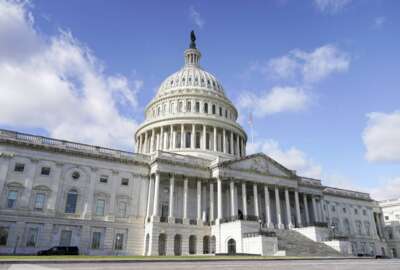One side of House trying to finish 2025 appropriations package early
You probably can't expect regular order when it comes to 2025 appropriations. One half of the House is working to wrap up work on federal funding early.
You probably can’t expect regular order when it comes to 2025 appropriations. Yet oddly, one half of the House is working to wrap up work on federal government funding early, before the end of the fiscal year. For details, the Federal Drive with Tom Temin spoke with WTOP Capitol Hill correspondent Mitchell Miller.
Interview Transcript:
Tom Temin Mitchell, let’s start with that Republican spending plan. Tell us details. And what kind of a battle will this set up?
Mitchell Miller Well, there’s some good news and some bad news. The good news is that House Republicans are actually out with their spending plan for fiscal year 2025. Also, the new Appropriations Committee chair, Tom Cole, is a veteran at this. He knows how it works. The bad news, for Democrats at least, is there are a lot of cuts that they are not going to like. The total presentation of the spending plan comes out to about $1.6 trillion, and this also includes big cuts for non-defense spending. Those are the ones that the Democrats are going to be raising hackles about. What we’re going to see this week, though, is the start of the markup sessions. This week we’ll look at the military construction and VA subcommittee, marking up their bill. Then the legislative branch subcommittee is going to follow a couple of days later. So ultimately, the goal and this is very optimistic from Congressman Cole, is that all 12 bills would be finished by the Appropriations Committee by early July. And the majority leader, Steve Scalise, has said he wants to actually pass the bills before the August break. We will have to see if that happens. I highly doubt it. But nonetheless, the process is beginning. So, this is where the battle is going to begin. And of course, you’re going to get a lot of pushbacks from the Democrats in connection with this, in part because, they are going to point out that under the previous agreement with former House Speaker Kevin McCarthy. Yes. Going all the way back to that, there was actually supposed to be an increase of defense and non-defense spending of about 1%. Instead, under this proposal from Tom Cole, the non-defense spending would be cut by more than 5%. So, you can see there’s going to be a big fight over that in the months ahead, right?
Tom Temin Because the Senate is still in Democratic hands, and they have a different approach. Probably people want to get what they can get done before the election. Is that fair to say?
Mitchell Miller Right. That’s a great point, because a lot of House Republicans, frankly, are waiting and saying they don’t want to do some of these things about until they know that, in their view, that former President Trump is going to get reelected, and then that will change the whole set of equations related to what spending goes toward. So, you’re right, this is going to be a big issue moving forward. So, I think that’s why, a large reason why we’re not going to get to this optimistic timetable that they’re looking at, because everything is just going to get pushed back as we get into the heavy part of the campaign season.
Tom Temin Right. Is there any early signs of what’s going on with the National Defense Authorization Act at this point?
Mitchell Miller Well, it’s still pretty early on it. I mean, that was that is one, as you know, that there is some bipartisan agreement on. So, they want to move forward on that. But I think it’s going to be incremental. That one will actually probably have more progress than some of these other plans that we’re looking at.
Tom Temin All right. And then with respect to some of the federal management issues, telework just will not die down as a point of discussion in Congress.
Mitchell Miller Right? You had the Homeland Security and Governmental Affairs Committee looking at the federal telework bill this past week, and they were hoping to move it forward. The chairman of that committee, Gary Peters, had plans to get some of the legislation, including the Telework Transparency Act, to move forward. But several lawmakers had a lot of reservations about what was being done or not done, as we’ve talked about in the past. Iowa Senator Joni Ernst still is digging in her heels on some of the things. Just saying that federal agencies are not giving up to date information on telework, the things that she thinks that need to be updated, and the agencies are getting pressed again by lawmakers to provide more of their data, what they’re doing to actually get people back, how much is being done, what’s the productivity? And then also, there’s another bill, that’s being proposed in the Senate. This is a bipartisan bill from Mitt Romney and Senator Joe Manchin of West Virginia. The Back to Work Act. What they would like to do is basically get 60% of federal workers back in the office. As you know, that would be, an increase from what is the goal, essentially, of the Biden administration of 50%. And there’s been some problems with agencies getting to that. So, a lot of angst related to telework still churning here on Capitol Hill.
Tom Temin We’re speaking with Mitchell Miller, Capitol Hill correspondent for WTOP. And then there are some DC sorts of DMV regional issues. This FAA reauthorization, the Virginia and Maryland delegations were not able to keep the increase in flights out of Reagan National. So, is there going to be like a 747 departure for Narita leaving from whatever their runway is?
Mitchell Miller 1901 no. But the people of San Antonio, Texas, are probably happy to know that there will likely. Be a flight in and out of Reagan National from San Antonio that was backed by Texas Senator Ted Cruz, pointing out that that’s a big military area and that they would like to get a direct flight right into Reagan National Airport since it’s so close to the Pentagon. This was an area what was really striking to me that the overall bill was passed overwhelmingly in the House and the Senate, and really, it was only the members from the Washington area with just a few others who were opposed to the FAA authorization. I think that’s because there were so many other agreements related to this big five-year bill, that they just didn’t want to hold it up to what some people think, at least from other parts of the country, is a more parochial issue. Obviously, the members from this area have very strong feelings about that and think it’s going to make it more unsafe that there’s going to be added delays for air passengers. But nonetheless, when you looked at the Senate vote, for example, it was really only the two Virginia senators and the two Maryland senators that voted against this legislation. But I think we will see this battle come back once again once the reauthorization comes back five years from now.
Tom Temin Wow. And then that bill also debated the people debating it, talked about the Francis Scott Key Bridge in Baltimore. What is the federal funding picture of that for the moment?
Mitchell Miller Well, that’s really interesting. There was an effort to actually attach funding related to the key bridge to the FAA reauthorization that failed. So that was another setback for local lawmakers. So now they’re just trying to move it forward in the Senate, primarily at this point. But there was a really interesting hearing in connection with this, this past week where, the head of the NTSB gave some new details related to the investigation, but there were a lot of concerns raised by Republican lawmakers about the cost. Now, the Biden administration has already said that under the federal rules, as they are now, 90% will be paid for. But there’s a 10% that Maryland still needs to get. And there are some issues about whether or not, at least in the view of Republicans, that a blank check is being written here for some of the things that are happening. And then there’s also a big push to make sure that the owner of the cargo ship that crashed into the bridge and its insurers actually pay some money that would go toward reconstruction of the bridge. Although one lawmaker pointed out that in a previous battle related to this, something similar, it took more than a decade to get the money from the insurer in that case. So, a lot of the people from, particularly the Maryland delegation are saying, let’s just get this money into the pipeline now. And then if we get money later on in connection with settlements and that type of thing, we can put it toward the overall spending plan and recompense, basically the taxpayers.
Tom Temin And there’s nothing too small for Congress to get involved with. Now, the RFK site in Washington, while we’re on the subject of the region, there’s one senator that thinks that the designer of the original old former Redskins logo needs to be recognized. What the heck is that all about?
Mitchell Miller Right? This is another interesting twist. There is always some kind of political drama in connection with, Washington’s football team now, the commanders and RFK Stadium, and this is basically legislation now before the Senate, which has passed the House, which would clear the way for RFK to be redeveloped by DC and would transfer the leasing rights essentially to DC, from the National Park Service. And the interesting thing that came up last week was Montana Senator Steve Daines, during a subcommittee hearing, basically brought up the old Redskins helmet and put it on the dais and said, we need to look at a way to honor the Native American family that came up with this logo originally and see if the team can somehow work with them. Now, what he is making very clear is he does not want to bring back the old team’s name because he knows that’s very controversial. But what he wants to do is, is some, in some way honor the family, the that came up with this and say, let’s not just put it on the ash heap of history, that this was a big part of the team during its really its heyday during the Super Bowl years. It was developed in the 1970s and then eventually, of course, was taken away over the last couple of years because of controversy related to the team’s name. Steve Daines is basically holding up this legislation until he sees that there is some kind of agreement between the team and the Native American. It’s the Blackfeet Nation, which is from Montana, and that’s why he is involved.
Tom Temin Well, there must be a big locker storage facility full of the former team gear. Maybe they can ship it out there and still wear that logo and pride.
Mitchell Miller I guess it’s interesting, by the way, Tom, that when he brought up the helmet, he pointed out that he was given this helmet by the team and former members and it’s all autographed. So, we know that it here in the Washington area, there is, as you said, all kinds of paraphernalia like this and in people’s basements and areas where they display it. But. It’s a fascinating development here with the, the team and RFK.
Copyright © 2025 Federal News Network. All rights reserved. This website is not intended for users located within the European Economic Area.
Tom Temin is host of the Federal Drive and has been providing insight on federal technology and management issues for more than 30 years.
Follow @tteminWFED






